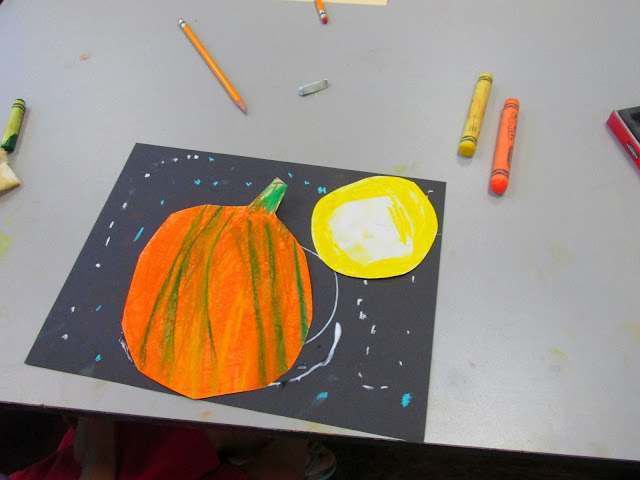It to is October. There are lots of fun pumpkin art projects. With the fours this week, we used crayon to draw our pumpkins. It was a step by step guided drawing. We add some yellow, orange, and green crayon to our pumpkins. I start early talking about seeing the variety of colors and shades in nature. Then we chalked them and rubbed the chalk into the paper. I hold up two fingers and tell them that we are smearing the chalk with just two fingers, otherwise many of them would smear with both hands. Some still do!!! Honestly, there was chalk every where. Some of the students went home with pretty orange looking smudged clothes. Thankfully chalk washes out.
I cut their pumpkins out quickly while they used a wipe and worked on cleaning their hands and their area up a bit. I gave them a piece of black construction paper and went around with the glue. They added their pumpkin and then used white and blue chalk to add stars. I also discuss how the stars are all over the sky and can by very random looking. Many of them want to add a line of stars at the top of the paper. With the stars, I show them how to press and mark. I have found that most of the fours will just beat the chalk on the paper unless I give some instructions. I also tell them that if they beat the chalk, then they are through working on their pictures. I do give some grace and repeat the instructions, but a four year old can destroy the soft chalk pretty quickly if they are hammering it on the table.
Next year I might grind up a bit of yellow chalk to to sprinkle on their papers as well. One of the girls got some of the yellow on her paper and I really thought it was a nice touch. I cut out moons and let them add some yellow chalk to the moon and then glue it in the night sky.
Our art concept this time was drawing big and using our space. I also like to introduce different materials to the kids early on. The chalk is messy but they are so much more comfortable with the materials later on if I give them some opportunities in preschool. I find their art to be enchanting.














